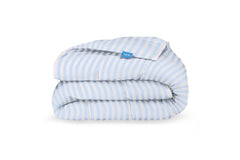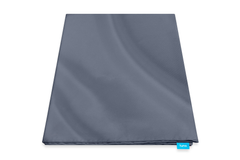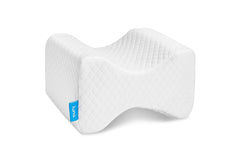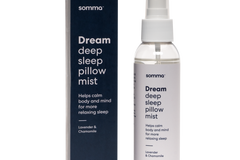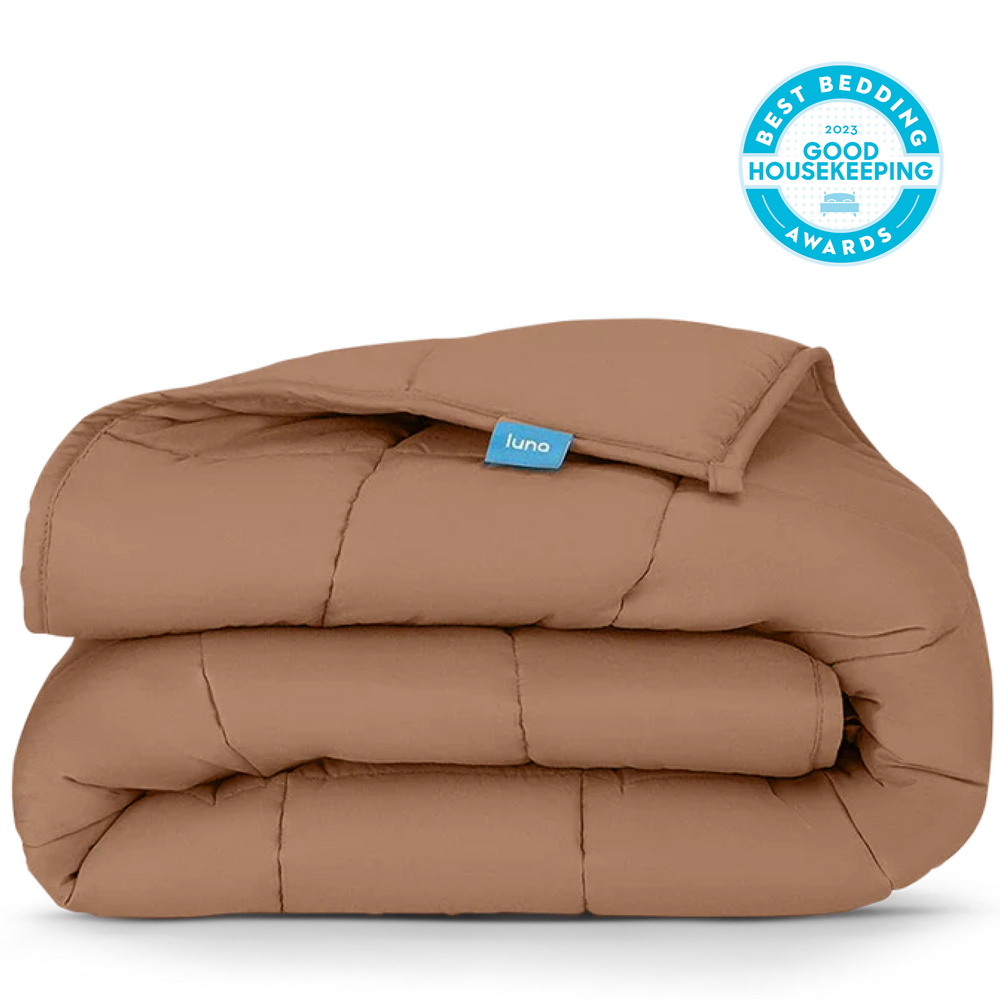What Are Weighted Blankets Made Of?
Weighted blankets can be constructed with a variety of materials, including cotton, flannel, bamboo, linen, and rayon. The fill inside of a weighted blanket—what makes a weighted blanket heavy—may include microfiber beads, sand, steel beads, pebbles, or grains.
Each of these materials has its own pros and cons, so before you start shopping, check out our guide to weighted blanket materials. Here, we’ll explain what weighted blankets are made of, which materials should be avoided, and what you need to know before purchasing your first weighted blanket.
Read on for a full explanation of weighted blanket materials, or use the links below to navigate throughout this post.
- How Are Weighted Blankets Made?
- What Type of Fillers Go in Weighted Blankets?
- Materials to Avoid in Weighted Blankets
- What Materials Are Best for Weighted Blankets?
How Are Weighted Blankets Made?
Weighted blankets are made with an exterior fabric, usually something soft, like cotton, linen, or fleece. This is the part that’s soft and cozy when you snuggle up to it. On the inside, weighted blankets are evenly filled with materials, such as beads, that help weigh it down. To prevent beads and similar materials from spilling out, they’re usually sewn into little pockets throughout the blanket. The added weight of the fill creates the deep pressure, hug-like sensation that is the science behind weighted blankets and their benefits.
By using a weighted blanket, many individuals have found relief from:- Insomnia: Weighted blankets mimic deep pressure therapy, which can contribute to an increase in serotonin production (the happy hormone) and a decrease in cortisol (the hormone that makes you feel stressed). This serotonin boost, in combination with less stress, can help individuals with insomnia fall asleep and stay asleep more regularly.
- Sensory disorders: According to Penn Medicine, individuals with Autism Spectrum Disorders, including Autism and Asperger’s, can find relief from overstimulation and stress with the help of a weighted blanket. While many people with sensory disorders feel overwhelmed by noise and touch, the feeling of a weighted blanket can actually soothe stress and provide comfort in potentially overwhelming situations.
- Anxiety: Most people will experience some level of anxiety at one point or another. Whether it’s temporarily brought on by work or family stress, or a diagnosed anxiety disorder, anxiety can have detrimental effects on quality of sleep and life in general. Penn Medicine suggests that weighted blankets can help the body transition from flight/fight mode into rest mode, helping to alleviate some of the physical and emotional symptoms associated with anxiety.
In addition to these applications, weighted blankets have been cited as effective in alleviating symptoms associated with other conditions, including fibromyalgia, restless leg syndrome, PTSD, depression, and ADHD.
What Type of Fillers Go in Weighted Blankets?
So, what are weighted blankets made of, and what makes them so heavy? There are a few possibilities. Weighted blankets can be filled with materials such as micro glass beads, sand, steel beads, pebbles, and grains.
Each of these fill materials has its own advantages and drawbacks, which can influence how you decide which weighted blanket is best for you. Let’s take a closer look at what’s inside of a weighted blanket, and what benefits each of these materials has to offer.
Micro glass beads
Micro glass beads are a smooth and environmentally-friendly alternative to plastic poly pellets, which are another commonly used material. While popular for their accessibility and cost, poly pellets aren’t considered completely non-toxic and can have an unsettling sound and texture that may irritate some individuals. In addition to their comforting texture, micro glass beads are usually denser than other materials, like poly pellets, which means less filling is required, creating a slimmer, more mobile design. Micro glass beads are also machine washable, making it convenient to clean and care for your weighted blanket— head to our blog for a quick explainer on how to wash your weighted blanket.
Lastly, micro glass beads are completely non-toxic and hypoallergenic, which makes them a great option for individuals with sensitivities to certain textiles.
Sand
Although it’s not very common, sand can also be used as a filler material. Sand that’s used in manufacturing is typically a combination of organic and synthetic materials, making it more susceptible to clumping together, especially when wet. As you might imagine, clumping can become a big problem when it’s time to wash a sand-filled weighted blanket. In fact, some sand blankets may not restore their original shape after machine washing.
Sand filling also has the potential to be much messier than other materials—make sure to look for stitching reinforcements if you’re considering a blanket filled with sand or other similar materials.
Steel beads
Steel beads are commonly used as a filler for weighted blankets because they’re durable, machine washable, and heavy, which means you need fewer units to achieve the desired weight and pressure. The main drawback for steel beads is the fact that they’re usually noisier than other materials, such as micro glass beads. If you’re sensitive to sound, especially when you sleep, a steel bead-filled blanket may not be the best option for you.

Pebbles
Believe it or not, the answer to “what’s inside a weighted blanket” may be found in your own backyard or local beach. Pebbles and rocks are an organic, cost-effective weighted blanket material, but they’re usually not as comfortable as the other options we’ve discussed so far. Because they are an organic option and have unique individual shapes and sizes, it’s difficult to evenly distribute weight when working with rocks and pebbles as weighted blanket materials.
Grains
You can also find weighted blanket materials in your kitchen pantry. Uncooked grains, pastas, and dried beans can all be used as fillers for weighted blankets and similar products, such as heating pads. Grains and beans are readily available and inexpensive, which makes them an attractive material for some manufacturers. However, over time these materials disintegrate, and therefore, aren’t a very durable option.
Materials to Avoid in Weighted Blankets
Now that we’ve answered “what’s in a weighted blanket?”, let’s discuss some of the things that shouldn’t be inside of your weighted blanket.
While much of what should or shouldn’t be used as a weighted blanket material comes down to your personal preference, many individuals want to avoid materials that contain trace amounts of toxins. Although they’re sealed within a blanket cover, plastic poly pellets may have small amounts of toxins, fire retardants, and preservatives.
What Materials Are Best for Weighted Blankets?
When shopping for a weighted blanket, you’ll want to consider the exterior and interior materials, weight, and other factors, like whether the blanket is machine washable. Ultimately, this choice depends on your personal preference, but micro glass beads are a very popular weighted blanket material.
Micro glass beads offer machine washable convenience, even weight distribution, a compact design, and they’re completely hypoallergenic and non-toxic.

Find peace and comfort with Luna weighted blankets
If you struggle with restlessness and discomfort at bedtime, our weighted blankets may be the solution to sleepless nights. Luna blankets are made with 100% polyester & microfiber made from recycled plastic bottles and micro glass beads, providing comfort and confidence in the materials you snuggle up with at bedtime. As for the exterior, Luna blankets are available in soft sherpa fleece, cozy cotton, and cooling bamboo.
For more information on how Luna works, how much weighted blankets should weigh, and more, check out our blog. Ready to order your Luna blanket today? Shop our collection of weighted blankets and accessories.
